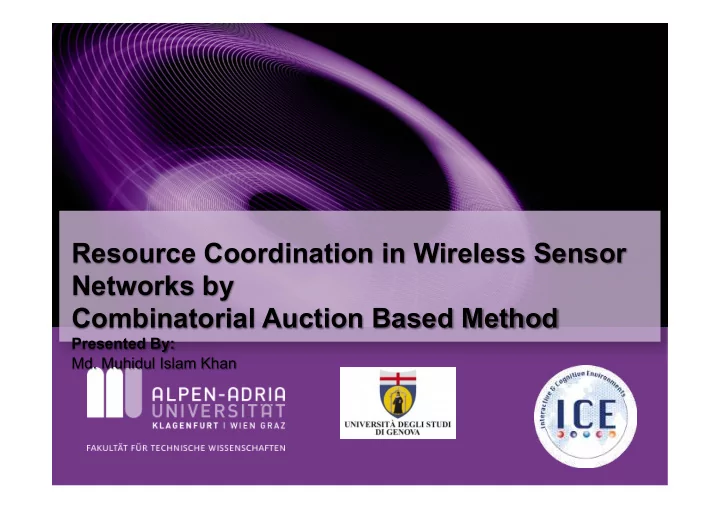

Resource Coordination in Wireless Sensor Networks by Combinatorial Auction Based Method Presented By: Md. Muhidul Islam Khan
Overview § Description of the problem § Challenges and design issues § Goals § Proposed approach § Simulation results § Conclusion and future works
Resource coordination in WSN § Dynamically assignment of available resources of sensor nodes. § Collaborative environment for resource management. § Allows sensor nodes to self schedule its tasks. § Helps to find out the best allocation of tasks to resources. § Helps to increase the lifetime of the network.
Resource Coordination Framework Available ¡ Resource ¡ ¡ Infrastructure ¡ Resource Monit Assignme or nt Coordina5on ¡Methods ¡ Goals ¡ Offline ¡ Periodic ¡ Trigger ¡ On-‑demand ¡ Issued ¡by ¡changes ¡ in ¡network ¡
Challenges and Design Issues § What coordination method to use. § How to monitor a resource assignment. § How to model the WSN and application. § How to learn the best coordination.
Goals § Extend the lifetime of the network. § Communication with neighbor nodes by local information. § Tasks allocation and runtime adaptation of resources. § To learn the best scheduling of tasks.
Combinatorial Auction § Combinatorial auctions are a great way to represent and solve distributed allocation problems. § It is helpful when the bid is composed of several items. § Problem: most of the winner determination solutions that exists are centralized.
PAUSE Auction § The PAUSE (the Progressive Adaptive User Selection Environment ) auction is a combinatorial auction and the problem of winner determination is distributed amongst the bidders. § Provides a bidding algorithm for agents in a PAUSE auction, the PAUSEBID algorithm. § This algorithm always return the bid which is maximizing the bidders utility.
PAUSE Auction § The most widely used auction in multi-agent systems. § Agents can place bids for sets of items. § Has been used in many systems where there is a set of tasks need to distributed between agents with different preferences.
PAUSE Auction § Combinatorial Auction is applicable to a large number of distributed allocation problems and multi-agent coordination problems § PAUSE auction has been developed and distribute the winner determination problem among agents § The existing centralized auctions don’t fit multi-agent systems where: § Agents have own computational resources § Agents have localized information
The PAUSE Auction § Each bid b composed of b items :the set of items the bid is over b value : the value or price of the bid b agent : the agent that placed the bid b {b items , b value , b agent } § At the end of each stage k, set B { b1, b2,b3,..} of the current best bids is generating and all agents know the best bid for every subset of size k or less.
The PAUSE Auction At each stage: § Bidders can use bids from other agents from previous round. § The sum of bid prices in each submitted bid set should be bigger than currently winning bid set. § There will be a set of currently winning bids which maximizing the revenue.
The PAUSE Auction § Also at each stage the goal of each agent i is to maximizing it’s utility where v i is the value function for this agent is: § Agent i must find g* such that
Bidding Algorithm
Bidding Algorithm
Bidding Algorithm β γ j Objective ( j ) . S = α + + j j D η j S Signal Strength of Node J. j Resource price. η j D The distance between the target and the node. Equilibrium Constants. α β γ
Bidding Algorithm CompCost refers to Computation cost E refers to remaining energy T Ideal Time Gap IG V dd R 2 nV CPU CompCost ( R , f ) CV V ( I e )( ) = + T CPU dd dd 0 f f K ( V c ) ≅ dd −
Simulation Required CPU cycle: Sensing: 10 M Hz Transmit: 26 M Hz Receive: 26 M Hz Sleeping: 0 Energy requirement: Sensing: 0.0000841 J Transmit: 0.00233 J Receive: 0.00231 J Sleeping: 0.000012 J Ideal time gap: Sensing: 25 msec Transmit: 10 msec Receive: 10 msec Sleeping: 0
Simulation
Simulation
Object Tracking Application Using Our Approach Node Node A C Node B
Tasks Executions Over Time Steps Tasks ¡Execu0ons ¡for ¡Node ¡B ¡ Node Node A Sleep ¡ C Sense ¡ Transmit ¡ 1 ¡ 9 ¡ 17 ¡ 25 ¡ 41 ¡ 49 ¡ 57 ¡ 65 ¡ 81 ¡ 89 ¡ 97 ¡ 33 ¡ 73 ¡ Receive ¡ Time ¡Steps ¡ Node B Tasks ¡Execu0ons ¡for ¡Node ¡A ¡ Tasks ¡Execu0ons ¡for ¡Node ¡C ¡ Sleep ¡ Sleep ¡ Sense ¡ Sense ¡ Transmit ¡ Transmit ¡ 1 ¡ 7 ¡ 13 ¡ 19 ¡ 25 ¡ 31 ¡ 37 ¡ 43 ¡ 49 ¡ 55 ¡ 61 ¡ 67 ¡ 73 ¡ 79 ¡ 85 ¡ 91 ¡ 97 ¡ 1 ¡ 9 ¡ 17 ¡ 25 ¡ 33 ¡ 41 ¡ 49 ¡ 57 ¡ 65 ¡ 73 ¡ 81 ¡ 89 ¡ 97 ¡ Receive ¡ Receive ¡ Time ¡Steps ¡ Time ¡Steps ¡
Conclusion and Future Works § Our method helps to increase the lifetime of the network. § Simulation results show better performace. § To design our state space with more system variables. § To consider some other tasks like aggregation in our system. § To apply other learning algorithms and to find out their efficiency. § To find out the scalability of this approach.
THANK YOU !!!! muhidulislam.khan@a au.at
Recommend
More recommend